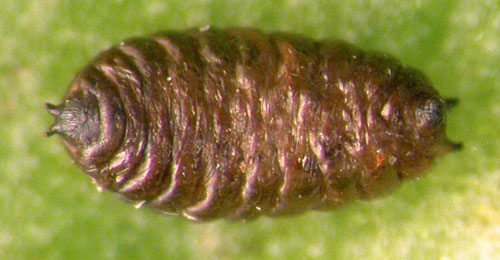|
||||||
|
Phytomyza
sedicola Hering, 1924 Phytomyza
sedicola Hering, 1924a. Z. wiss. InsektBiol. 19:
33, 40 |
|||||||||||||||||||||||||||||||||||||||||||||||||||||||||||||||||||||||||||||||||||||
|
Leaf-miner: A shallow, irregularly linear mine which can develop into a secondary blotch (Spencer, 1972b: 90). Pupation internal, the puparium loose in the mine (Spencer, 1976: 494). Upper-surface, whitish (shallow), strongly contorted corridor, that may form a secondary blotch. Frass in a few, widely scattered grains. Pupation mostly within the mine; in front of the brown puparium lies a preformed exit slit (Bladmineerders van Europa). Larva: The larvae of flies are leg-less maggots without a head capsule (see examples). They never have thoracic or abdominal legs. They do not have chewing mouthparts, although they do have a characteristic cephalo-pharyngeal skeleton (see examples), usually visible internally through the body wall. The larva is described by de Meijere (1926) and Griffiths (1976c). Puparium: The puparia of flies are formed within the hardened last larval skin or puparium and as a result sheaths enclosing head appendages, wings and legs are not visible externally (see examples). Brown (Spencer, 1976: 494). The puparium is illustrated in (Bladmineerders van Europa).
Hosts in Great Britain and Ireland:
Hosts elsewhere:
Time of year - mines: May and July (Hering, 1957). Time of year - adults: August. Distribution in Great Britain and Ireland: Westmorland (Keswick) (Spencer, 1972b: 90). Distribution elsewhere: Widespread in continental Europe including Denmark, Finland, Norway, Sweden (Spencer, 1976: 494), Germany (Spencer, 1976: 578), Austria, Czech Republic, Hungary, Italian mainland, Lithuania, Poland, Romania and Switzerland (Fauna Europaea). NBN Atlas links to known host species:
British and Irish Parasitoids in Britain and elsewhere:
|
|
|
|
| External links: | Search the internet: |
| Biodiversity Heritage Library Bladmineerders van Europa British leafminers Encyclopedia of Life Fauna Europaea NBN Atlas NHM UK Checklist |
Find
using Google Find using Google Scholar Find images using Google |
| Last updated 10-Jul-2019 Brian Pitkin | ||

